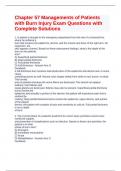Chapter 57 Managements of Patients
with Burn Injury Exam Questions with
Complete Solutions
1. A patient is brought to the emergency department from the site of a chemical fire,
where he suffered a
burn that involves the epidermis, dermis, and the muscle and bone of the right arm. On
inspection, the
skin appears charred. Based on these assessment findings, what is the depth of the
burn on the patients
arm?
A) Superficial partial-thickness
B) Deep partial-thickness
C) Full partial-thickness
D) Full-thickness - Answer-Ans: D
Feedback:
A full-thickness burn involves total destruction of the epidermis and dermis and, in some
cases,
underlying tissue as well. Wound color ranges widely from white to red, brown, or black.
The burned
area is painless because the nerve fibers are destroyed. The wound can appear
leathery; hair follicles and
sweat glands are destroyed. Edema may also be present. Superficial partial-thickness
burns involve the
epidermis and possibly a portion of the dermis; the patient will experience pain that is
soothed by
cooling. Deep partial-thickness burns involve the epidermis, upper dermis, and portion
of the deeper
dermis; the patient will complain of pain and sensitivity to cold air. Full partial thickness
is not a depth
of burn.
2. The current phase of a patients treatment for a burn injury prioritizes wound care,
nutritional support,
and prevention of complications such as infection. Based on these care priorities, the
patient is in what
phase of burn care?
A) Emergent
B) Immediate resuscitative
C) Acute
D) Rehabilitation - Answer-Ans: C
Feedback:
,The acute or intermediate phase of burn care follows the emergent/resuscitative phase
and begins 48 to
72 hours after the burn injury. During this phase, attention is directed toward continued
assessment and
Test Bank - Brunner & Suddarth's Textbook of Medical-Surgical Nursing 14e (Hinkle
2017) 1167
maintenance of respiratory and circulatory status, fluid and electrolyte balance, and
gastrointestinal
function. Infection prevention, burn wound care (i.e., wound cleaning, topical
antibacterial therapy,
wound dressing, dressing changes, wound dbridement, and wound grafting), pain
management, and
nutritional support are priorities at this stage. Priorities during the emergent or
immediate resuscitative
phase include first aid, prevention of shock and respiratory distress, detection and
treatment of
concomitant injuries, and initial wound assessment and care. The priorities during the
rehabilitation
phase include prevention of scars and contractures, rehabilitation, functional and
cosmetic
reconstruction, and psychosocial counseling.
3. A patient in the emergent/resuscitative phase of a burn injury has had blood work and
arterial blood
gases drawn. Upon analysis of the patients laboratory studies, the nurse will expect the
results to indicate
what?
A) Hyperkalemia, hyponatremia, elevated hematocrit, and metabolic acidosis
B) Hypokalemia, hypernatremia, decreased hematocrit, and metabolic acidosis
C) Hyperkalemia, hypernatremia, decreased hematocrit, and metabolic alkalosis
D) Hypokalemia, hyponatremia, elevated hematocrit, and metabolic alkalosis - Answer-
Ans: A
Feedback:
Fluid and electrolyte changes in the emergent/resuscitative phase of a burn injury
include hyperkalemia
related to the release of potassium into the extracellular fluid, hyponatremia from large
amounts of
sodium lost in trapped edema fluid, hemoconcentration that leads to an increased
hematocrit, and loss of
bicarbonate ions that results in metabolic acidosis.
4. A patient has experienced an electrical burn and has developed thick eschar over the
burn site. Which of
the following topical antibacterial agents will the nurse expect the physician to order for
the wound?
A) Silver sulfadiazine 1% (Silvadene) water-soluble cream
, B) Mafenide acetate 10% (Sulfamylon) hydrophilic-based cream
C) Silver nitrate 0.5% aqueous solution
D) Acticoat - Answer-Ans: B
Feedback:
Mafenide acetate 10% hydrophilic-based cream is the agent of choice when there is a
need to penetrate
thick eschar. Silver products do not penetrate eschar; Acticoat is a type of silver
dressing.
Test Bank - Brunner & Suddarth's Textbook of Medical-Surgical Nursing 14e (Hinkle
2017) 1168
5. An occupational health nurse is called to the floor of a factory where a worker has
sustained a flash burn
to the right arm. The nurse arrives and the flames have been extinguished. The next
step is to cool the
burn. How should the nurse cool the burn?
A) Apply ice to the site of the burn for 5 to 10 minutes.
B) Wrap the patients affected extremity in ice until help arrives.
C) Apply an oil-based substance or butter to the burned area until help arrives.
D) Wrap cool towels around the affected extremity intermittently. - Answer-Ans: D
Feedback:
Once the burn has been sustained, the application of cool water is the best first-aid
measure. Soaking the
burn area intermittently in cool water or applying cool towels gives immediate and
striking relief from
pain, and limits local tissue edema and damage. However, never apply ice directly to
the burn, never
wrap the person in ice, and never use cold soaks or dressings for longer than several
minutes; such
procedures may worsen the tissue damage and lead to hypothermia in people with
large burns. Butter is
contraindicated.
6. An emergency department nurse has just admitted a patient with a burn. What
characteristic of the burn
will primarily determine whether the patient experiences a systemic response to this
injury?
A) The length of time since the burn
B) The location of burned skin surfaces
C) The source of the burn
D) The total body surface area (TBSA) affected by the burn - Answer-Ans: D
Feedback:
Systemic effects are a result of several variables. However, TBSA and wound severity
are considered the
major factors that affect the presence or absence of systemic effects.




